Australia fires: A visual guide to the bushfire crisis
Record-breaking temperatures and months of severe drought have fuelled a series of massive bushfires across Australia.
The fires, burning since September, have intensified over the past week, with a number towns evacuated. High temperatures and strong winds are forecast for the weekend, creating further fire risk.
Twenty people have so far been killed - including three volunteer firefighters - and about six million hectares (60,000 sq km or 14.8 million acres) of bush, forest and parks have been burned.

Source: Nasa Firms. Map built using Carto
If you can't see the map click here.
New South Wales has been worst affected
In the worst-hit state, New South Wales (NSW), fire has affected more than four million hectares, destroying more than 1,300 houses and forcing thousands to seek shelter elsewhere.
Hot, dry weather combined with prolonged drought and strong winds have created perfect conditions for fire to spread rapidly.
More than 130 fires were burning across the state on Friday, in the bush, mountain forests and national parks, with about 60 still not contained by firefighters and posing a risk to lives.
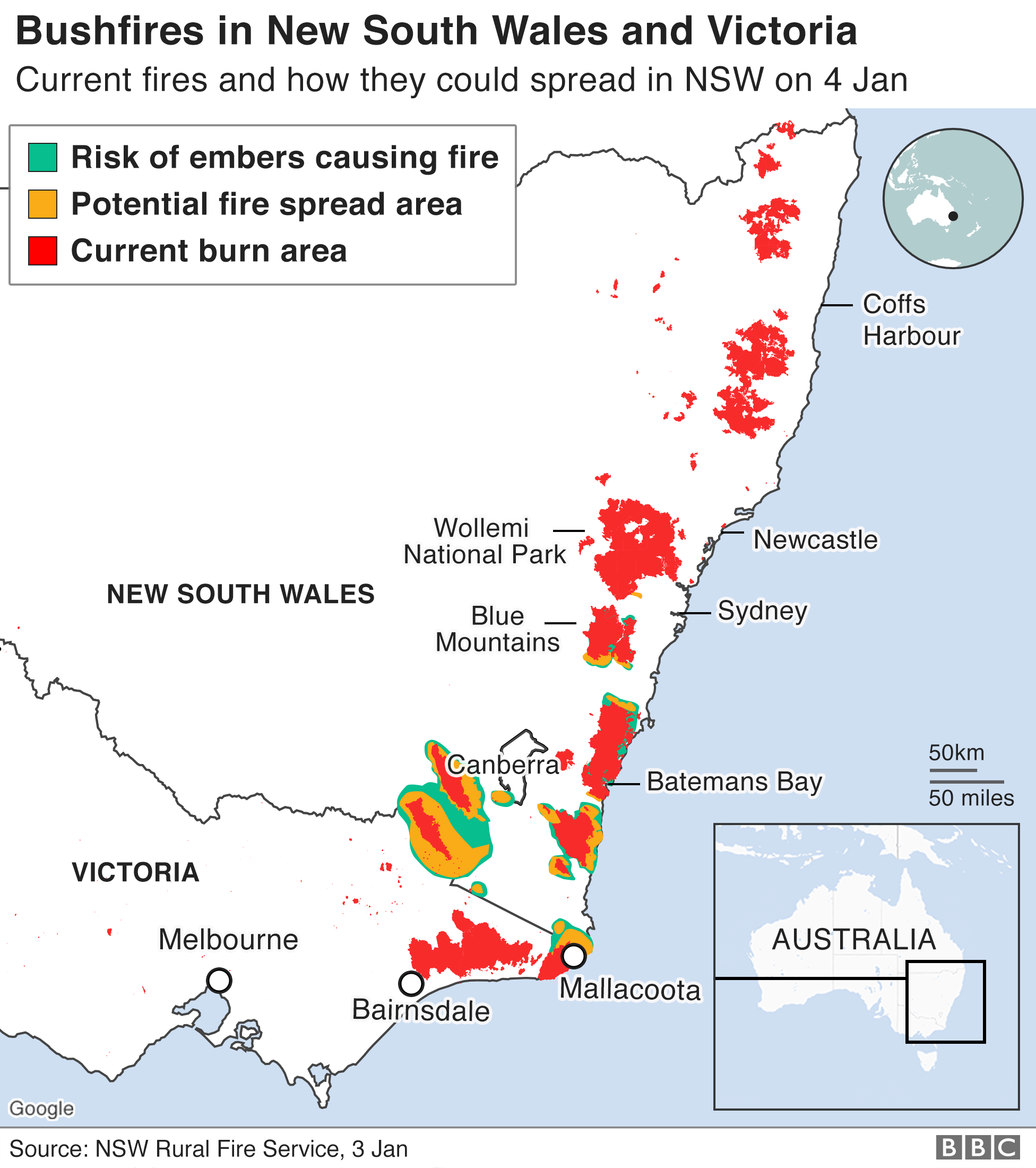
The fires have been exacerbated by 40C temperatures and strong winds, creating difficult conditions for the thousands of firefighters deployed in the field.
The small town of Balmoral, south-west of Sydney, was largely destroyed and scores of homes were razed amid catastrophic conditions on 22 December.
But conditions are still dangerous and a state of emergency for NSW has come into force. Parks, trails and camping grounds have been closed and holidaymakers have been told to urgently leave a 260km (160-mile) stretch of NSW coast before Saturday, 4 January, when extreme conditions are forecast.

Other states are also suffering
In Victoria, more than 800,000 hectares have been burned. Fires have been burning since late November but the have caused devastation in recent days, leaving two people dead and destroying around 43 homes in East Gippsland.
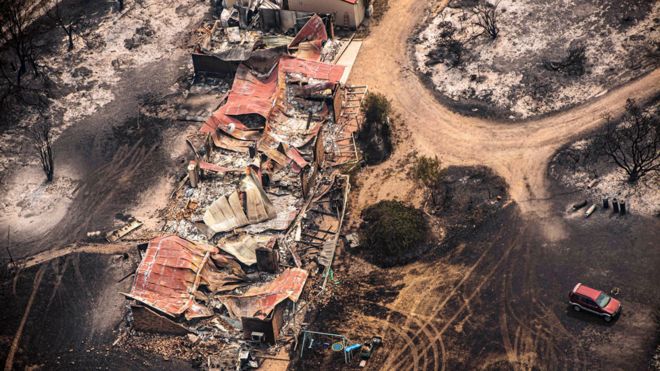 In the small town of Mallacoota, residents fled to the beach on 31 December, with only a change in the wind direction keeping the fire from reaching them on the shore.
In the small town of Mallacoota, residents fled to the beach on 31 December, with only a change in the wind direction keeping the fire from reaching them on the shore.Around 1,000 tourists and residents were eventually evacuated by the Australian navy and taken further down the coast.
The military has sent troops, ships and aircraft to the region to help relocation and firefighting efforts.
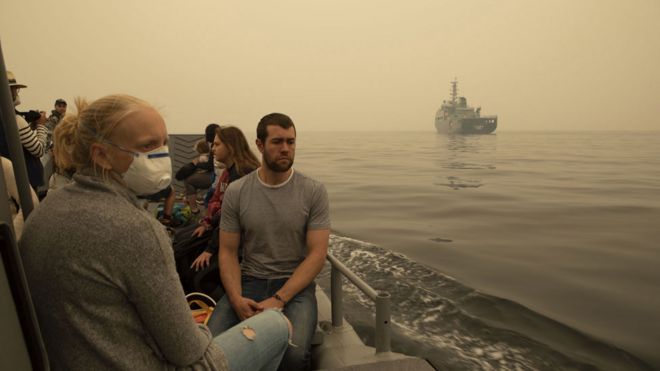
A state of disaster has been declared for the worst-hit areas in Victoria, which allows the authorities to enforce evacuations and let emergency services take over properties.
Satellite images show the spread of smoke from fires in Victoria and NSW, which has affected air quality as far away as New Zealand.
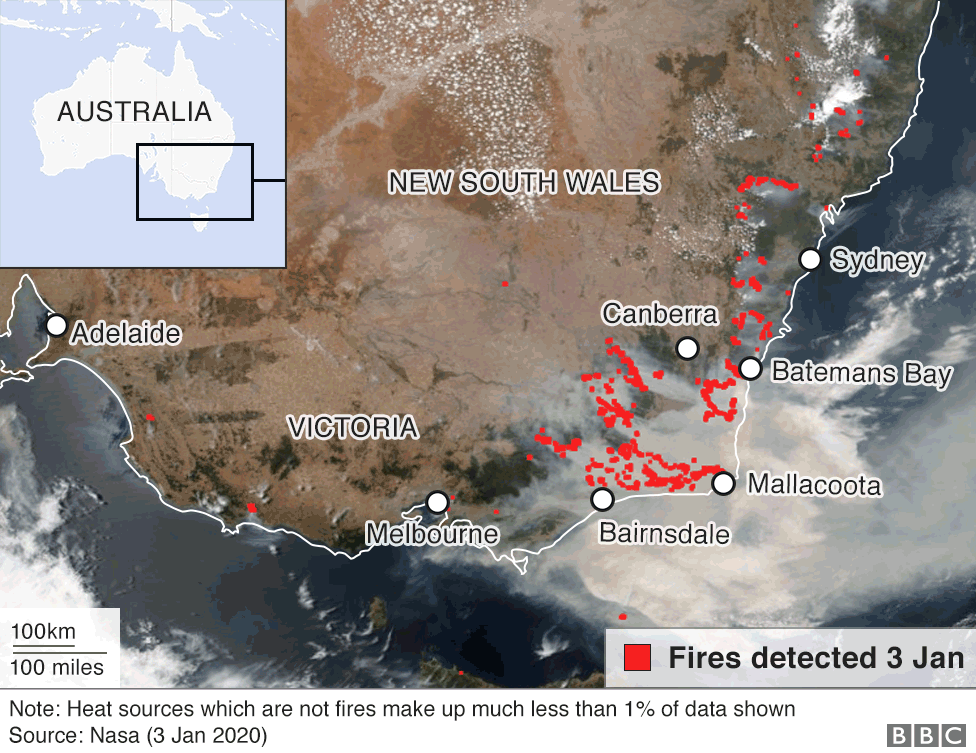
In the state of South Australia, the Cudlee Creek fire is reported to have destroyed more than 80 homes in the Adelaide Hills region.
The fires are also thought to have destroyed up to a third of the vines that provide grapes for the Adelaide Hills wine industry.
In the Australian capital Canberra - an administrative region surrounded by NSW - bushfire smoke meant air quality there was rated the third worst of all major global cities on Friday, according to Swiss-based group AirVisual.
Very hot and dry conditions, with strong winds and thunderstorms are expected - posing further fire risk.
The fires have been worse than usual
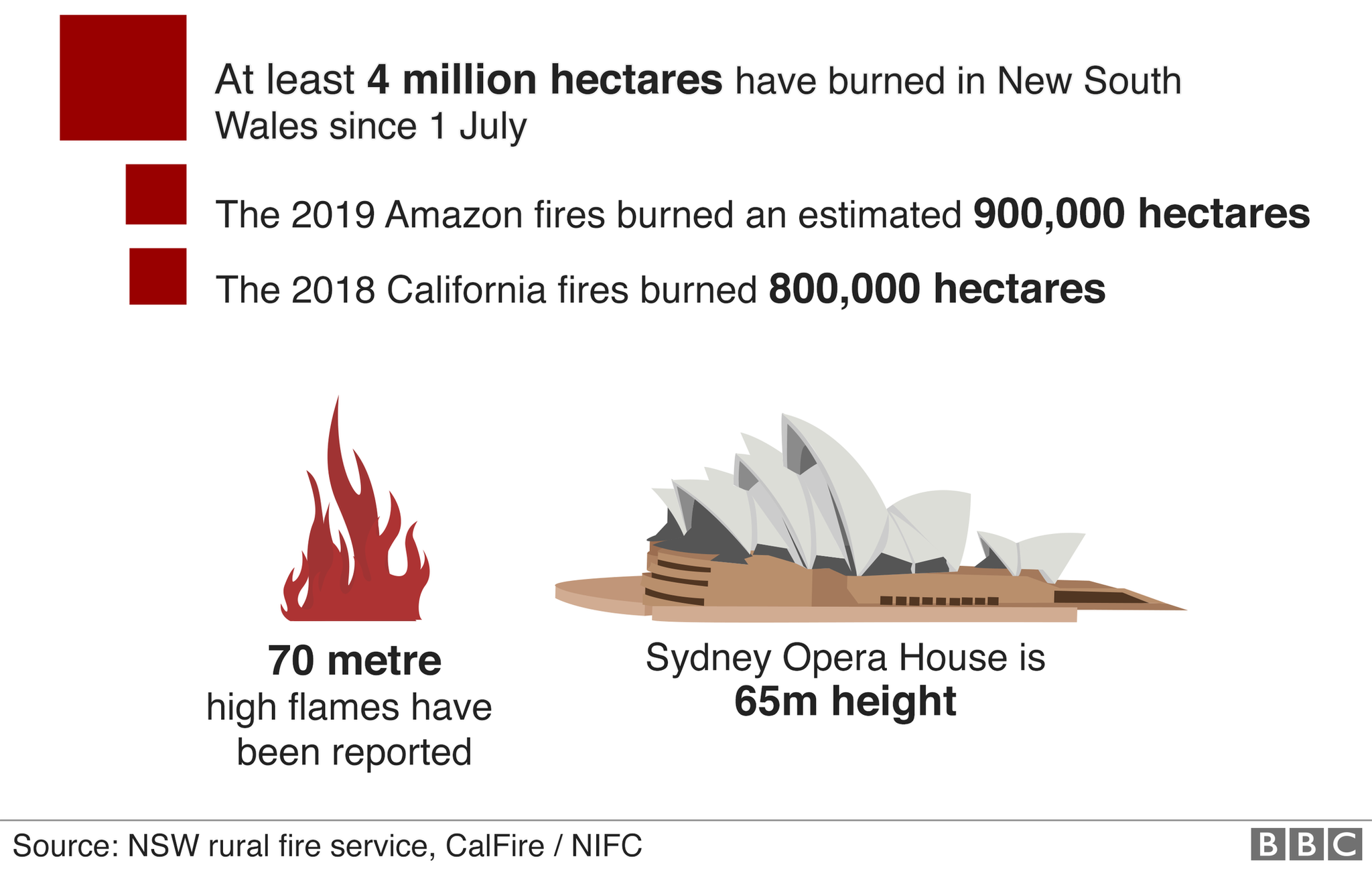
To put the fire damage in New South Wales in perspective, some 900,000 hectares were lost in the 2019 Amazon fires and around 800,000 hectares burned in the 2018 California wildfires.
The total area of land affected by the NSW fires would cover most of the south of England.
Although Australia has always had bushfires, this season has been a lot worse than normal.
Humans are sometimes to blame for starting the fires, but they are also often sparked by natural causes, such as lightning striking dry vegetation.
Once fires have started, other areas are at risk, with embers blown by the wind causing blazes to spread to new areas.
Bush fires themselves can also drive thunderstorms, increasing the risk of lightning strikes and further fires.
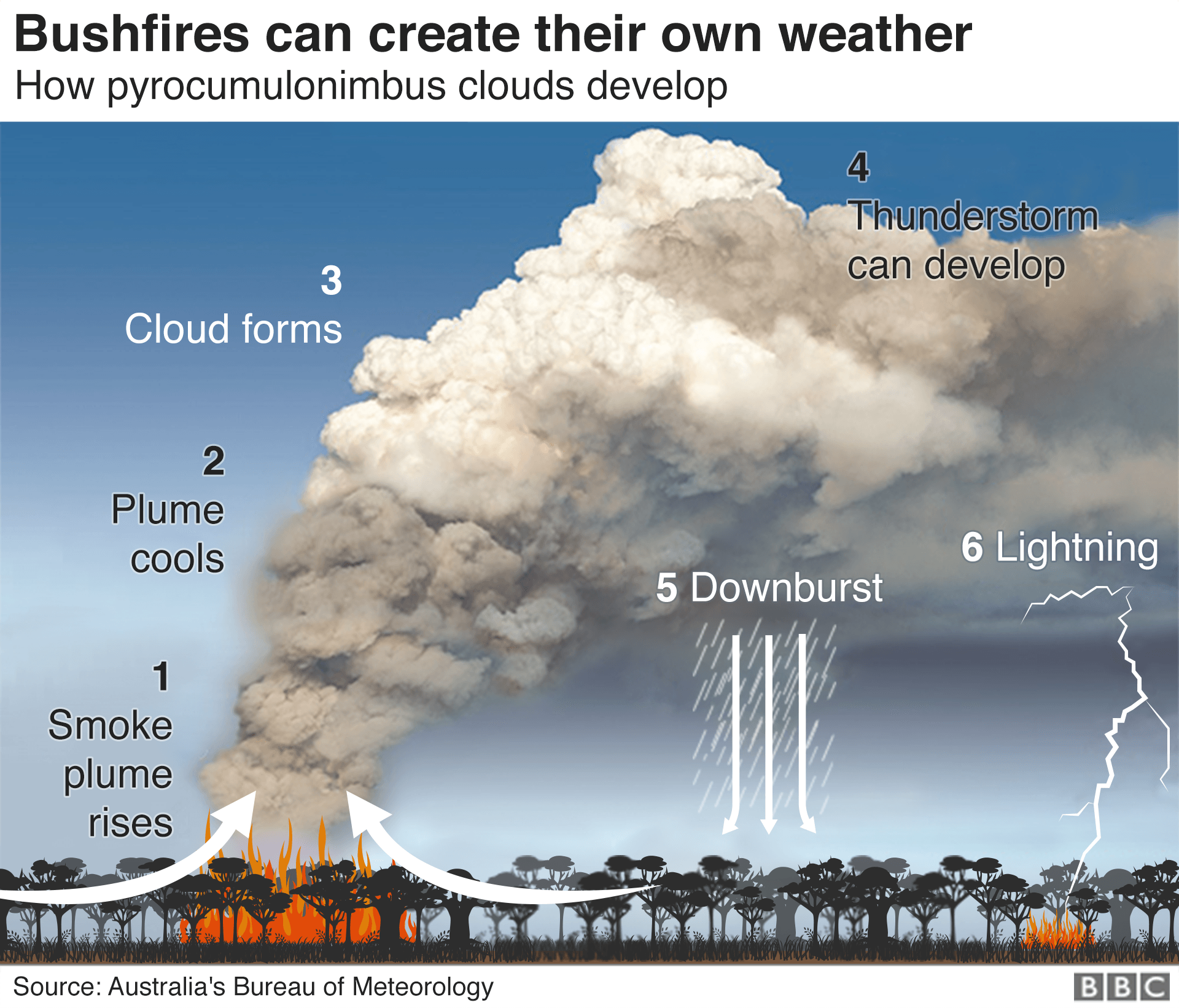
The number of people killed as a result of the fires since September 2019 is higher than in recent years.
Australia's deadliest bushfire disaster was "Black Saturday" in February 2009, when some 180 people died in Victoria.
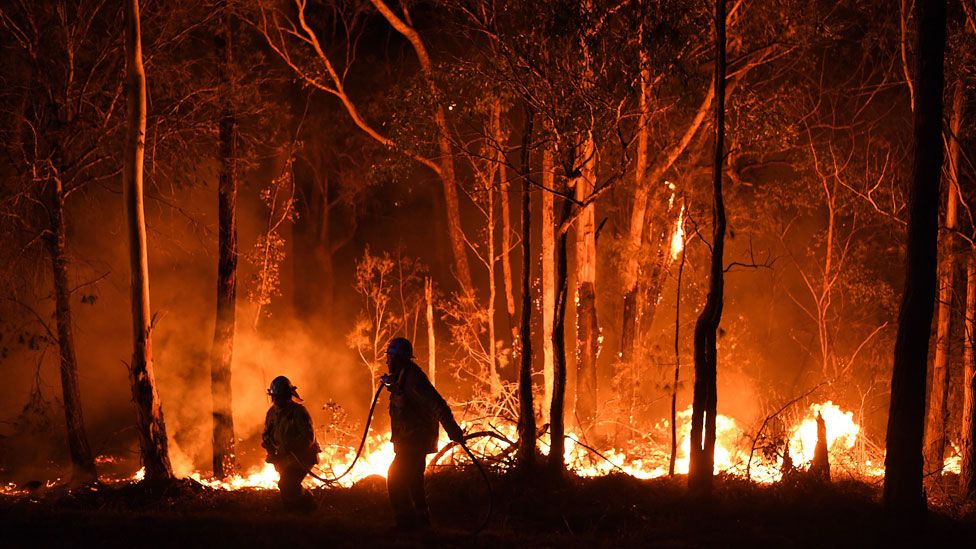

Comments
Dear Amparo, I haven't had time to get to this forum much recently...but just saw this, and other posts you've shared about meditations to bring ease to the Australian bushfires...thank you. xo
I also feel to mention that there's a mass meditation focus being held at Uluru, organized by elders of the Anangu people (traditional custodians of Uluru and central region) being held on January 12th, on which there's also a powerful planetary alignment. I don't have a lot of info about it yet, but Uluru is considered to be the Solar Plexus -Fire Chakra - of the planet, and although this meditation is global and cosmic, it also has an Australian focus....to bring healing and balance to the fire element, through the Solar Plexus chakra....
Here are times, for anyone who feels to send light and love with the Anangu and all gathered for ceremony and singing love into the songlines (planetary energy flow lines), in synchronized timing (otherwise, at any time that suits, with the intention to unify with the Uluru gathering and focus):
There are two major Synchronised Songline Activation Time co-ordinates: 12th Jan 2020 Australia focus, all welcome
Australia focus, all welcome 12pm local time Uluru 11.30am Perth 12.30pm Brisbane 1.00pm Adelaide 1.30pm Sydney/Melbourne 2.30am London GMT 3.30am Central Europe 4.30am Jerusalem/Cairo/Cape Twn 5.30am Moscow, Russia 8.00am India Standard Time 10.30am Shanghai/Bali 11.30am Tokyo, Japan 3.30pm Auckland, NZ 6.30pm PST USA (11th) 7.30pm MST USA (11th) 9.30pm EST USA/Lima, Peru (11th)
12pm local time Uluru 11.30am Perth 12.30pm Brisbane 1.00pm Adelaide 1.30pm Sydney/Melbourne 2.30am London GMT 3.30am Central Europe 4.30am Jerusalem/Cairo/Cape Twn 5.30am Moscow, Russia 8.00am India Standard Time 10.30am Shanghai/Bali 11.30am Tokyo, Japan 3.30pm Auckland, NZ 6.30pm PST USA (11th) 7.30pm MST USA (11th) 9.30pm EST USA/Lima, Peru (11th)
From Perth, there are many ground crew sending light across Australia to the east; there are fires from Queensland to Tasmania, with the most intensity in NSW and Victoria, and also South Australia 'in the middle'....we have been blessedly almost fire-free here so far this summer, and the light-grid in the West is holding.... so we keep flowing the light stream east to a high light node cluster in/around Sydney, to then fan out north and south to the fire-affected areas.... <3
Love&Blessings of Peace and Renewal to all affected areas, people, animals and plants....and all sending light and love from around the world <3